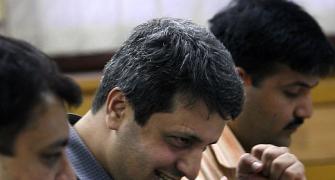It will be difficult for the Indian equity to outperform overall growth to the extent bullish observers expect, explains Jaimini Bhagwati.
 The World Bank has reduced its projection for global growth in 2015 from 3.4 to three per cent, while raising its forecast for United States growth from three to 3.2 per cent in its bi-annual Global Economic Prospects report.
The World Bank has reduced its projection for global growth in 2015 from 3.4 to three per cent, while raising its forecast for United States growth from three to 3.2 per cent in its bi-annual Global Economic Prospects report.
This report estimates Indian growth at 6.4 per cent in 2015-16 and at seven per cent for each of the subsequent two years.
The minutes of the United States Federal Reserve's December 2014 meeting suggest that it could raise its benchmark interest rate from zero to 0.25 per cent in April 2015.
What do debt market indicators of major economies, and the prospects for Indian growth, imply for our equity markets in 2015?
The euro zone's gross domestic product (GDP) is about 72 per cent that of the European Union, and the latter's 2014 GDP of $18.4 trillion constituted the largest economic bloc globally.
The euro zone's headline inflation dropped to negative 0.2 per cent in December 2014, and it was 0.3 per cent in the previous month.
Excluding food and fuel, core Consumer Price Index (CPI) went up by 0.8 per cent in December 2014 - substantially lower than the European Central Bank (ECB) target, of two per cent.
To put matters in perspective, the last time the euro zone's headline CPI was negative was back in 2009. The ECB will probably overcome the opposition of the Bundesbank's president, and decide at its next council meeting on January 22 to buy euro-zone government bonds.
European banks, unlike those in the United States, have been slower to resume lending since these banks have not set off adequate capital against stressed assets.
Consequently, even if the ECB opts for more liquidity through quantitative easing, it does not follow that the euro zone will sharply rebound from its ongoing post-2008 slump.
Given Europe's aging population and inflexible social security, health, unemployment and other benefits, it is unlikely that further reduction in euro interest rates would immediately boost consumption or investment.
Interest rates are at never-before levels already - for example, the German five-, 10- and 30-year nominal Bund rates were at zero, 0.48 and 1.22 per cent respectively on January 14. The German and the Japanese government yield curves are relatively flat stretching out to 30 years, reflecting little market concern about inflation over the long term. The implication is tepid growth in Europe and Japan.
High unemployment and lower real wages have raised the popularity of a leftist radical party called Syriza in Greece and fresh national elections are scheduled for January 25.
If Syriza wins, it would make provocative demands to reschedule the servicing of its net sovereign debt that currently stands at 170 per cent of GDP. Greek GDP was just 1.8 per cent that of the euro zone in 2014.
However, a Greek exit from the euro zone could have contagion effects and widen the borrowing spreads of the larger Spanish and Italian economies.
Although there is little patience left in Berlin or Brussels for Greece, it is likely that the loans to Greece would be rescheduled somehow.
For example, there could be a moratorium on principal repayments for the next 10 years, and the maturity of euro 140 billion of European Financial Stability Facility (EFSF) loans, which have an average maturity of 30 years, could be extended by another 10 years.
The United States stock markets have been steadily up for the last six years and the Dow Jones index has risen 147 per cent from a post-financial sector meltdown low of 7,063 on February 1, 2009, to 17,427 on January 14, 2015.
The FTSE in the United Kingdom has gone up by 34 per cent from mid-2010 till now, and the Nikkei in Japan has risen by 70 per cent over the same period.
In India, the total return on the Nifty has been 14 per cent since the new government took over in May 2014.
Except for an approximately three-per-cent drop in Indian stock indices within a day, 10 days back, market sentiment has been positive.
Oil prices are sharply down and on January 14, 2015, Brent crude was at $46 a barrel. As a net oil importer, this is positive for India's trade balances.
However, such a rapid and steep fall in oil prices is probably a harbinger of slower global growth even if the United States remains a positive outlier.
What should Indian investors watch out for in our stock markets? For a change, in addition to foreign institutional investor (FII) sentiment, domestic investments in equity need to be tracked.
In 2014, net FII investment in Indian stocks totalled $16 billion and investments in equities through Indian mutual funds amounted to $7.3 billion.
The FII behaviour is influenced by India's credit rating, which would depend on the forthcoming Union Budget and implementation of overdue steps on several fronts.
These include easier availability of coal, passing of the land acquisition ordinance, labour reforms and so on.
The rupee-dollar exchange rate is important for investors who measure their gains/losses in convertible currency terms.
A potential risk factor may be that the FIIs are assuming, based on past experience, that the Reserve Bank of India (RBI) will not let the rupee weaken in accordance with inflation differentials between India and developed countries.
Further, Indian firms that consciously choose to borrow in low nominal interest rate foreign currencies may be wrong in expecting the RBI and the government to prevent the rupee from depreciating.
Bullish Indian equity market watchers are projecting the Nifty to be around 10,000 by end-2015. That is, a 20 per cent plus rise from the current level of around 8,300.
At best, we should expect Indian GDP growth in 2015-16 at six-seven per cent and CPI inflation at four per cent - that is, nominal growth of around 11-12 per cent.
It would be difficult for the index to outperform overall growth to this extent, given the slow to no growth in the euro zone and Japan, and the possibility of an interest-rate hike in the United States.
To sum up, we need to take the legislative and administrative steps to get moving on infrastructure and power sectors, and guard against the possibility of sudden capital outflows.
Clearly, the 2015-16 Budget numbers need to be fiscally conservative.
Thereafter, we need to get domestic interest rates down and correct the manifest overvaluation of the rupee before there can be any credible expectation of a 20 per cent rise in Indian stock prices between now and December 2015.
The writer, a former Indian High Commissioner to the United Kingdom and a World Bank Treasury specialist, is currently RBI Chair Professor at ICRIER.










